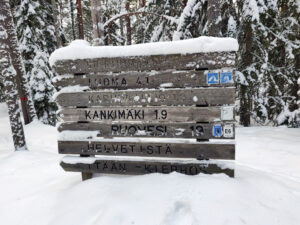
Trail markings that are customer-oriented ensure an enjoyable stay at the trail by guiding visitors surely to the places of interest as well as keeping them safe at the same time. They are there, but do not distract visitors from the main thing.
Author: Kaisu Isomäki
Markings help stay on the trail
From the visitor’s perspective the most important thing is that the nature trail or a hiking area has a functional and cohesive set of signs and markings. Clear markings prevent visitors from getting frustrated when they cannot find the correct path straightaway. In a worst-case scenario poor trail marks may lead to someone getting lost.
There are several ways to mark nature trails. If the conditions are favourable, painting continuous marks on trees and rocks is an affordable method that works well if the color is visible enough. Visibility can be improved by using colored shapes with sharp edges and white borders around them. During winter though, painted marks are easily covered by snow. Because of that depending on the site, frequently placed separate marking posts might be a better option since they stand out from the terrain even when covered by snow. (Ollila & Kestilä 2018, 28.)
Although knowing who takes care of the site might not feel that important at the first glance, if there are any deficiencies or irregularities in the markings or something else needs to be reported, the information of the body responsible for the specific site needs to be easily accessible.
At the national level, the bodies responsible for trail markings are for example, Metsähallitus, various ministries, National Land Survey of Finland, Suomen Latu and Visit Finland. Regionally, the responsibility can lie with, for example, municipalities, different tourism and sports associations, and private landowners who have given up the area for recreational purposes. (Reittimerkinnät 2018a.)
Clarity and consistency are the base for good guidance
A regular trail marking system comprises different kinds of signs and markings on the route. The signs may for example instruct, recommend, warn or prohibit. The use and placement of warning signs is based on risk assessment. Prohibitions are based on official order. (Reittimerkinnät 2018b.) Well-designed trail markings are user-friendly and ensure a safe visit. They are clear, consistent, and they serve both domestic and international visitors. From the maintenance point of view, they are cost-effective. (Reittimerkinnät 2018a.) Cost-effectiveness means that they are easy and affordable to maintain, repair and replace and at best they serve visitors all-year around.
During the REILA Safety of Trail Marking, Pilot Area Lapland 2015–2018 project feedback from the trail markings was collected from the customers and other operators. Almost 70 % of the respondents would look for information of the trails beforehand, which highlights the importance of the advance information that needs to be easily available. Especially guidance to the start of the trail emerged as an information that was not always clear enough beforehand. Based on the research, visitors preferred that the signs and markings were primarily logical, clear, easily legible, and easy to spot. Respondents found that the most important feature of a signpost was its clarity of the content and its visibility under different weather and lighting conditions. “You are here” markings were found useful as a particular feature. (Ollila & Kestilä 2018, 8.)
Respondents did not find the material used or how well the signs blended into nature as important. Usually, the signs meant for nature trails are made of wood or metal. Wood is a material that is used to acquire a natural and traditional appearance. Downside of wooden material is that it has a short service life as in the course of time the material darkens and its visibility and legibility decreases. Additionally, wooden signs are difficult to update. Compared to wooden ones, metal signs have more urban feeling in them. They are resistant to changing weather conditions. With metal a clear and legible result can be accomplished easily and the separate parts can be updated if necessary. (Ollila & Kestilä 2018, 8, 35-36.)

Image 1: The legibility of some of the wooden signs in Helvetinjärvi national park has decreased over time. (Image: Kaisu Isomäki )
Trails have seasonal changes
People generally prefer to follow the clearest path that makes most sense to them. This should be considered when designing the trails and their markings for all seasons. Gravel at least at the start of the trail that stands out from the terrain is a good indication for people to follow (Ollila & Kestilä 2018, 28).
It is suggested that if the trail network is used differently in summer and winter separate seasonal maps should be created (Ollila & Kestilä 2018, 32). Many national parks in Finland have no winter maintenance. Though, because of number of visitors many trails are walkable even in very snowy winters. Snow can be a blessing or a curse when the path is made by the visitors themselves. Based on author’s own experience, for example, in Helvetinjärvi national park most visitors travel by foot during winter. Thanks to the number of visitors in winters there is usually a narrow but walkable circle trail from the main entrance of the park to the main attraction, Helvetinkolu Gorge. The other trails are not used in winter and are covered by snow so getting lost is quite impossible if one just follows others’ footsteps.
As in Helvetinjärvi the walking trails in the Koli national park have no winter maintenance. In summer there are about 80 km of marked trails of various lengths in Koli national park (Metsähallitus 2022). For snowshoers and skiers the area has a lot to offer in winter too. For regular visitors travelling by foot usually only the Trail of the Tops (1,4 km) circle path is open as the path is made by the visitors themselves. The staff of the Koli Nature Center Ukko kindly reminds visitors without skis or snowshoes to stay on the path so that no accidents happen. The issue with the visitor made winter path is that sometimes it differs from the actual path in the park. Without clear markings or an alternative map informing about the seasonal change of the trail, it feels confusing to reach the end of the path that should be a circle. In defense, the trail is not that long anyways but with a small seasonal additions like colorful ribbons on the tree branches the visitors could be guided around the park without any confusion, if people will anyways visit the park even in winter.
The theme of trail markings has been studied in the project Kurenniemi which is co-funded by the European union. Aforementioned key findings can be of help when designing the trail signs and markings and when planning their placements in the Kurenniemi area.
References
Metsähallitus. 2022. Koli National Park Trails. Cited 21 Apr 2022. Available at https://www.nationalparks.fi/kolinp/trails
Ollila, E. & Kestilä, S. 2018. Safe and customer-oriented trail marking. Lapland University of Applied Sciences Publications Serie D. Other publications 1/2018. Cited 20 Apr 2022. Available at https://blogi.eoppimispalvelut.fi/reittimerkit/files/2018/06/opastekokonaisuus_05062018_eng_pakattu.pdf
Reittimerkinnät 2018a. Reittimerkinnät laadun merkkinä. Cited 20 Apr 2022. Available at https://blogi.eoppimispalvelut.fi/reittimerkit/
Reittimerkinnät 2018b. Opastekokonaisuus. Cited 20 Apr 2022. Available at https://blogi.eoppimispalvelut.fi/reittimerkit/2018/02/26/muut-merkit/
Author
Kaisu Isomäki works as a project planner at the LAB University of Applied Sciences.
Illustration: Kaisu Isomäki
Published 6.6.2022
Reference to this article
Isomäki. K. 2022. Staying on the right path – remarks about visitor-friendly nature trail marking. LAB Pro. Cited and date of citation. Available at https://www.labopen.fi/lab-pro/staying-on-the-right-path-remarks-about-visitor-friendly-nature-trail-marking/






